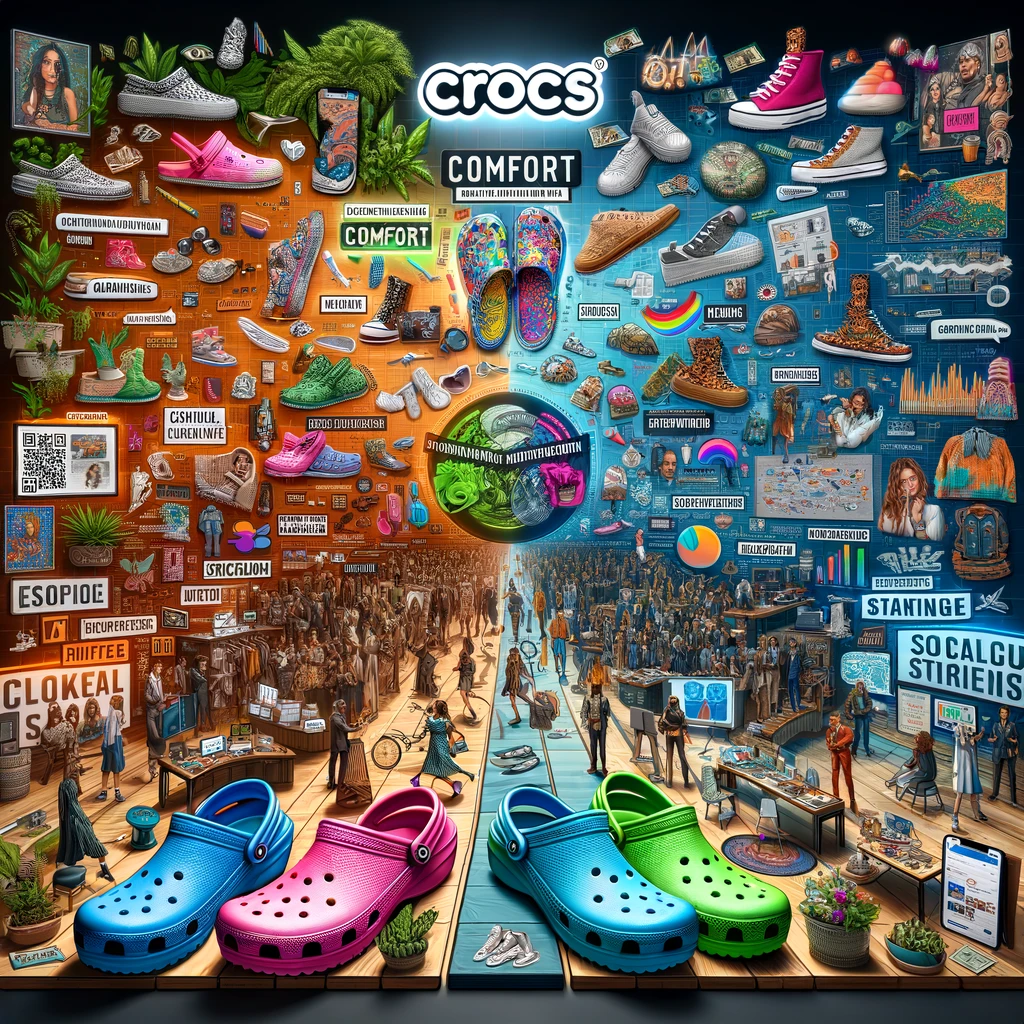Crocs, a brand that began as a niche product for boating enthusiasts, has transformed into a global phenomenon known for its distinctive, comfortable, and versatile footwear. The brand’s marketing strategy has played a crucial role in its success, helping Crocs to transcend its functional origins and become a fashion statement embraced by a diverse audience. Here’s a detailed look at the key elements of Crocs’ marketing strategy that have driven its remarkable growth.
1. Emphasizing Comfort and Functionality
At the heart of Crocs’ marketing strategy is the emphasis on comfort and functionality. Crocs’ signature material, Croslite, provides a unique combination of softness, durability, and comfort, which the brand highlights in its marketing campaigns.
- Comfort-Driven Messaging: Crocs consistently promotes the comfort of its shoes across all marketing channels. Whether through advertisements, social media posts, or in-store displays, the message is clear: Crocs are designed to keep you comfortable all day long.
- Versatile Uses: The brand showcases the versatility of its footwear, suitable for various activities and environments, from casual wear and outdoor adventures to professional settings and healthcare.
2. Bold and Innovative Collaborations
One of the most effective aspects of Crocs’ marketing strategy is its use of bold and innovative collaborations with high-profile designers, celebrities, and brands.
- High-Profile Partnerships: Collaborations with designers like Christopher Kane and Balenciaga have brought a high-fashion twist to Crocs, attracting a new audience and gaining media attention.
- Celebrity Endorsements: Partnerships with celebrities such as Justin Bieber and Post Malone have helped Crocs tap into different fan bases and stay relevant in pop culture. These collaborations often result in limited-edition collections that generate significant buzz and sell out quickly.
- Pop Culture Integrations: Collaborations with popular franchises like Disney, Marvel, and fast-food chain KFC have created unique, themed products that appeal to both fans of the franchises and Crocs enthusiasts.
3. Leveraging Social Media and Digital Marketing
Crocs has effectively leveraged social media and digital marketing to engage with its audience, promote its products, and drive sales.
- Engaging Content: Crocs creates engaging content that resonates with its diverse audience, from fun and quirky posts to user-generated content showcasing how fans style their Crocs.
- Hashtag Campaigns: The brand uses hashtag campaigns like #ComeAsYouAre to encourage customers to share their personal Crocs stories and photos, fostering a sense of community and inclusivity.
- Influencer Marketing: By partnering with influencers across various niches, Crocs reaches different segments of the market, from fashion influencers to lifestyle and wellness creators.
4. Strategic Retail and E-Commerce Initiatives
Crocs’ marketing strategy includes a strong focus on retail and e-commerce to enhance customer experience and accessibility.
- Omni-Channel Presence: Crocs maintains a robust omni-channel presence, ensuring that customers can purchase their products online, in Crocs-branded stores, and through various retail partners.
- E-Commerce Growth: The brand has significantly invested in its e-commerce platform, offering a seamless shopping experience with detailed product information, customer reviews, and personalized recommendations.
- Pop-Up Shops and Events: Crocs frequently sets up pop-up shops and participates in events to create unique, immersive shopping experiences that drive brand awareness and sales.
5. Sustainability and Social Responsibility
In recent years, Crocs has incorporated sustainability and social responsibility into its marketing strategy, appealing to environmentally conscious consumers.
- Sustainability Initiatives: Crocs has committed to becoming a net-zero company by 2030, focusing on using sustainable materials, reducing waste, and minimizing its carbon footprint. These initiatives are highlighted in marketing campaigns to showcase the brand’s commitment to the environment.
- Community Engagement: The brand actively participates in community engagement and charitable activities, such as donating shoes to healthcare workers during the COVID-19 pandemic. These efforts are promoted through various marketing channels to enhance the brand’s positive image.
6. Adapting to Trends and Consumer Preferences
Crocs has shown remarkable adaptability in responding to market trends and evolving consumer preferences, ensuring its continued relevance.
- Trend-Driven Designs: The brand frequently updates its product line with new designs and colors that reflect current fashion trends, appealing to both long-time fans and new customers.
- Customization Options: Crocs offers customization options like Jibbitz charms, allowing customers to personalize their footwear and express their individuality. This customization aspect is heavily promoted in marketing efforts, emphasizing the fun and playful side of the brand.
Crocs’ marketing strategy is a multifaceted approach that combines comfort-focused messaging, bold collaborations, effective use of digital and social media, strategic retail initiatives, and a commitment to sustainability. By staying true to its core values while continuously evolving and adapting to market trends, Crocs has successfully transformed from a niche product into a beloved global brand. The company’s ability to engage with a diverse audience and create a strong sense of community has been key to its ongoing success and growth in the competitive footwear industry.




